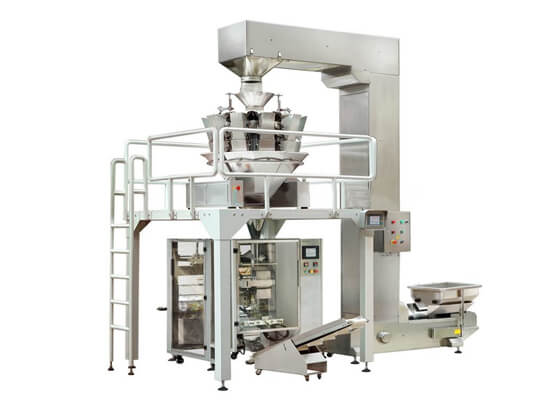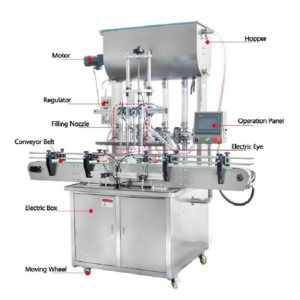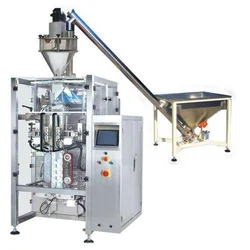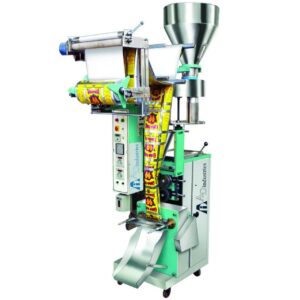Description
| Specification | Description |
|---|---|
| Packaging Speed | 100-500 packs per minute (adjustable) |
| Packaging Material | Suitable for various materials: plastic, aluminum, etc. |
| Packaging Types | Can handle pouches, trays, bottles, jars, etc. |
| Sealing Mechanism | Heat sealing, vacuum sealing, or combination |
| Packaging Size Range | Adjustable for different package sizes |
| Control System | PLC (Programmable Logic Controller) with touchscreen interface |
| Power Supply | 220V/380V, 50Hz/60Hz |
| Power Consumption | Depending on model, typically 5-10 kW |
| Air Pressure | 0.6-0.8 MPa (87-116 psi) |
| Machine Dimensions (LxWxH) | Varies depending on model, typically 3m x 2m x 2m |
| Weight | Varies depending on model, typically 1000-2000 kg |
| Material Handling | Automatic feeding, conveying, and discharge systems |
| Safety Features | Emergency stop button, safety guards, interlocks |
| Optional Features | Date coding, labeling, gas flushing, product inspection |
| Compliance | CE and other relevant safety standards |
Introduction to Automated Food Packaging Equipment
Automated food packaging equipment has revolutionized the food industry by simplifying its packaging processes with automation and advanced technologies. These consist of various machines created in such a way that they can fill, seal, label, and wrap food products accurately and consistently. Equipment for automated packing offers improved quality control, better safety features as well as increased productivity; it is therefore essential in maintaining the market position as well as enhancing freshness, and ensuring the integrity of products on shelves. In response to the growing demand for efficiency and sustainability, new developments are emerging in automated food packaging equipment that continue to influence the future of food packaging.
Types of Automated Food Packaging Equipment
Filling Machines: These machines are used to measure out exact quantities of food substances into containers like bottles, jars, or pouches. They are mainly applicable to liquids, powders, granules, and viscous substances.
Sealing Machines: Sealing machines guarantee that packaged foods remain safe while being delivered by ensuring the secure sealing of containers. They may use heat sealing, vacuum sealing, or induction sealing among other methods.
Labeling Machines: Labelling machines help in applying information labels to the containers used for preserving packed meat and fish among other things sold in stores like their nutritional contents besides expiry dates marked on them thus boosting accuracy at times when such information is required fast.
Wrapping Machines: Wrapping machines cover goods with items like plastic film or foil thereby protecting them from damage as well as spoilage under certain circumstances. For instance sweets, chocolates cakes etcetera commonly require this machine type.
Capping Machines: Capping machines ensure that caps or lids securely enclose containers keeping the contents intact all through till consumption. Any goods containing bottled liquids necessitate capping during the packing process.
How Automated Food Packaging Equipment Works
Automated food packaging equipment combines mechanical systems, electrical systems as well as pneumatic systems to function. Additionally, these devices are programmed with instructions that enable them to execute specific tasks like filling, sealing, labeling, or wrapping with high precision and consistency. Advanced sensors, actuators, and control systems enable accurate operation of the machines as well as monitoring various parameters like product weight, packaging integrity, and labeling alignment. Automatic packaging is made more efficient and flexible by the use of advanced technologies such as robotics and artificial intelligence.
Features and Functions
Precision: Automated food packaging equipment ensures that food products are filled, sealed, and labeled accurately through precise measurements.
Efficiency: Tasks that were previously done manually can now be performed by these machines thereby reducing human effort hence increasing production efficiency.
Versatility: Packaging materials used in automated packaging equipment can be used on several kinds of food items with various sizes of packages made for more versatile uses.
Quality Assurance: Modern sensors help to detect defects as well as inspect for the presence of foreign objects in packed foods which confirms their safety
Hygiene and Sanitation: These particular machines are built using cleanable materials and hence meet hygiene requirements set by industrial regulatory bodies such as the FDA.
Benefits of Automated Food Packaging Equipment
Increased Productivity: Automation speeds up packaging processes leading to higher production throughput and increased output
Improved Quality Control: Consistent product quality is assured by automatic systems thus reducing defective packaged products.
Cost Savings: The savings realized from the reduction in manual labor force together with waste minimization make automated packing beneficial for companies operating expenses (Pierce 2013).
Enhanced Safety: Because automation eliminates all possibilities of accidents during the final stages of food processing that are caused due to human error while carrying out this process manually, it therefore becomes very safe compared to manpower application.
Market Competitiveness: Quick reaction to market demands regarding packaging allows companies to stay ahead of competition within the industry.
Prolonged Shelf life: Automation and the right packaging help in extending the shelf life of food products, thereby reducing waste of foods and enhancing satisfaction among its customers.
The Future of Automated Food Packaging
AI and Machine Learning Integration: AI algorithms and machine learning models will aid in optimizing packaging processes, predicting maintenance needs, as well as improving efficacy.
Sustainable Materials for Packaging: The use of automation means that environment-friendly components can be used to wrap goods without compromising the requirements related to sustainability.
Customization and Personalization: Automatic packaging enables mass customization and personalization solutions in terms of packaging depending on the unique tastes and preferences of individual buyers.
IoT-enabled Smart Packages: Internet of Things (IoT) based technology will enable smart packages with real-time monitoring, tracking, interactive features, etc.
Robotics And Cobots: There will be increased use of robots as well as collaborative robots known as cobots in packaging functions. Such systems can perform complex tasks similar to those done by humans with dexterity and precision.
Most Frequently Asked Questions
What are the benefits associated with automated food packing equipment?
Increased output, better quality management, cost reduction, more secure work practices longer storage period for goods’ competitive advantage market
How do automated filling machines ensure accuracy?
Automated filling machines employ accurate measurement devices along with sensors for correct dispensation into containers.
Common Sealing Methods Used in Automated Packaging?
Heat sealing is often done by using a heat sealer. Some examples include vacuum sealing or induction sealing which apply to different product types’ package materials.
How does automated packing fit into sustainability?
Automatic packing equipment helps optimize packing processes as well as minimize waste while at it. Furthermore, this means allowing the adoption of eco-friendly materials and methods for packaging purposes.
What kinds of food products can be packed through these auto-machines?
These auto-machines can support different forms such as liquid or semi-liquid substances, powders, and granules among others.
Can automated packaging systems work with various package formats?
Automated packaging systems can be set up to accommodate different types of packages such as jars, bottles, or pouches.
How do labeling machines ensure the accurate placement of labels?
Labeling machines are equipped with highly precise mechanisms and sensors that are used in aligning the label on product containers with utmost precision and uniformity.
Can automated packaging equipment adapt to changes in production demand?
Certainly, these automated packaging equipment have been built to be flexible to cope with any eventual changes in the number of final goods required for a given production run.
What kind of maintenance is required for the automatic packing machine?
Regular cleaning and proper lubrication along with thorough inspection of parts guarantees the effective functioning of the equipment.
What justifies investment in automatic food packing equipment by companies?
Investment in automatic food packing equipment is justified by: Increasing productivity Reduced cost Enhanced quality Safer workplace Competitive advantage





